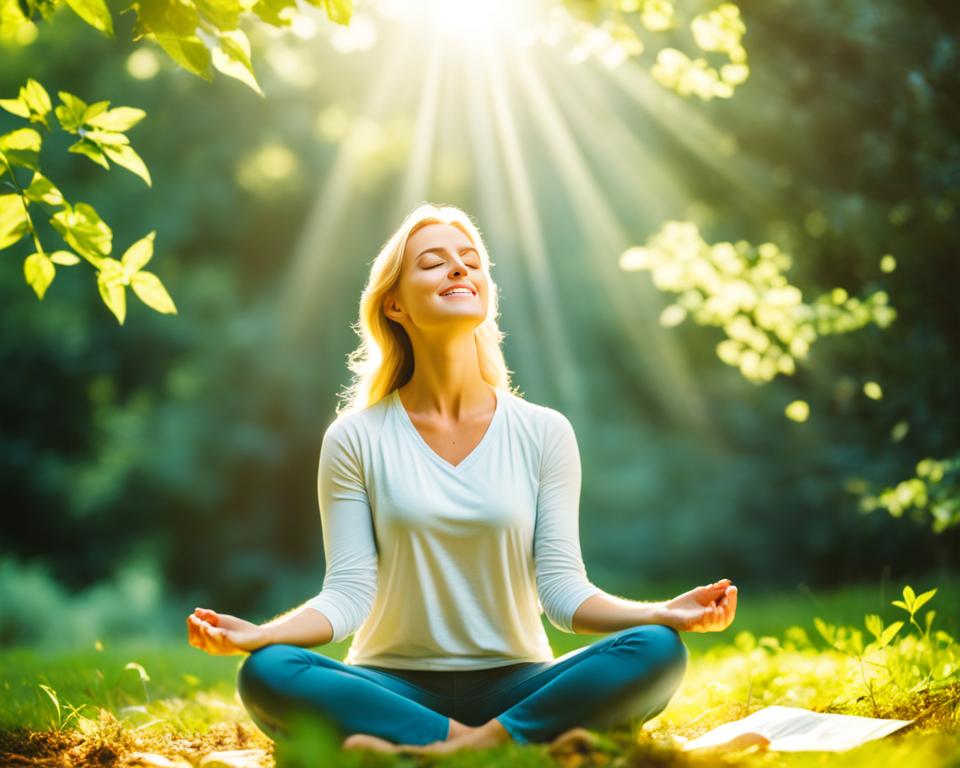Stress is a common experience in modern life, with significant impacts on our physical and mental well-being. Fortunately, there are numerous effective stress relaxation techniques that can help us achieve inner peace and balance. This comprehensive guide will explore a range of proven methods, including mindfulness, meditation, yoga, breathing exercises, and progressive muscle relaxation. By incorporating these techniques into our daily routines, we can learn to manage anxiety, improve our overall health, and enhance our quality of life.
Read more interesting information at ::vsok
Understanding Stress and Its Impact
Stress is a prevalent experience in modern life, with far-reaching implications for our physical and mental well-being. Understanding the nature of stress and its various effects is crucial in developing effective stress relaxation strategies and achieving a state of inner balance.
What is Stress?
Stress is the body’s natural response to perceived threats or challenges, triggering a series of physiological and psychological reactions. This response, commonly known as the “fight-or-flight” reaction, is designed to help us confront or avoid potential dangers. However, when stress becomes chronic or excessive, it can have detrimental physical and mental effects, leading to a range of health issues and impacting our overall anxiety management.
Physical and Mental Effects of Stress
Stress can have a profound impact on both our physical and mental health. Physically, prolonged stress can contribute to a range of issues, including elevated blood pressure, weakened immune system, digestive problems, and even an increased risk of heart disease. Mentally, stress can lead to feelings of anxiety, depression, irritability, and difficulty concentrating, ultimately affecting our overall well-being and quality of life.
By understanding the nature of stress and its multifaceted effects, individuals can take proactive steps to implement effective stress relaxation techniques and regain control over their physical and emotional well-being.
Mindfulness and Meditation Practices
Mindfulness and meditation are powerful tools for managing stress and promoting relaxation. These practices help individuals cultivate a greater sense of awareness, presence, and inner calm, which can have profound benefits for both physical and mental well-being.
Mindfulness Meditation
Mindfulness meditation focuses on the present moment, encouraging individuals to observe their thoughts, emotions, and physical sensations with a non-judgmental and accepting attitude. This practice helps reduce the tendency to dwell on the past or worry about the future, allowing one to find solace in the current experience. Consistent mindfulness meditation has been shown to decrease symptoms of stress, anxiety, and depression, while also improving focus, emotional regulation, and overall mental clarity.
Guided Meditation
Guided meditation involves following the soothing instructions of a teacher or audio recording to lead the practitioner through a relaxation or visualization exercise. This approach can be particularly helpful for beginners or those who find it challenging to maintain focus during meditation. Guided meditations often incorporate elements of mindfulness, imagery, and breathing techniques to promote a state of deep relaxation and inner peace.
Mantra Meditation
Mantra meditation involves the repetition of a specific word, phrase, or sound, known as a mantra. This practice can help calm the mind and induce a meditative state by providing a focal point for attention. The rhythmic recitation of a mantra can have a hypnotic and calming effect, allowing the practitioner to let go of worries and distractions. Mantra meditation has been used for centuries in various spiritual and cultural traditions as a means of achieving relaxation, self-reflection, and inner harmony.
Yoga for Relaxation
Yoga is a comprehensive mind-body practice that can be highly effective in reducing stress and promoting relaxation. This ancient discipline combines physical postures, breath control, and meditation to help individuals achieve a state of profound calm and inner peace. By incorporating yoga into their daily routines, individuals can tap into the powerful stress-relieving benefits of this holistic practice.
Gentle Yoga Poses
Gentle yoga poses, such as restorative backbends, forward folds, and supported twists, can be particularly beneficial for individuals seeking stress relief. These gentle movements help to release muscle tension, improve circulation, and promote a sense of deep relaxation. The focus on slow, controlled breathing during these poses further enhances the stress-reducing effects, allowing the mind and body to unwind and enter a state of profound tranquility.
Restorative Yoga
Restorative yoga is a specific style of yoga that is designed to facilitate deep relaxation and restoration. This practice utilizes props, such as blankets, blocks, and bolsters, to support the body in various resting postures. By minimizing muscular effort and promoting a sense of surrender, restorative yoga can effectively alleviate stress, reduce anxiety, and induce a state of profound relaxation. The extended duration of the poses, coupled with the use of soothing music or guided meditation, further enhances the stress-relieving benefits of this practice.
Breathing Exercises
Breathing exercises are a simple yet powerful tool for managing stress and inducing a state of relaxation. By focusing on our breath, we can activate the parasympathetic nervous system, which is responsible for the “rest and digest” response, effectively counteracting the physiological effects of stress.
Diaphragmatic Breathing
Also known as belly breathing or abdominal breathing, diaphragmatic breathing is a highly effective stress relaxation technique. This method involves breathing deeply through the nose, allowing the belly to expand, and then exhaling slowly through the mouth. This deep, rhythmic breathing can help reduce anxiety, lower blood pressure, and promote a sense of calm.
Alternate Nostril Breathing
Alternate nostril breathing, or Nadi Shodhana, is a traditional breathing exercise that can be particularly beneficial for stress relief. This technique involves closing off one nostril at a time, alternating between the left and right nostrils during inhalation and exhalation. This balanced, rhythmic breathing can help to calm the mind, reduce anxiety, and enhance overall well-being.
Progressive Muscle Relaxation
Progressive muscle relaxation (PMR) is a powerful stress reduction technique that can help individuals achieve deep, restorative relaxation. This method, developed by physician Edmund Jacobson in the 1920s, involves systematically tensing and then releasing different muscle groups throughout the body. By consciously focusing on the contrast between muscle tension and relaxation, individuals can learn to recognize and manage their body’s stress response, ultimately leading to a profound state of progressive muscle relaxation and mental calm.
The practice of PMR begins by drawing attention to a specific muscle group, such as the feet or hands. The individual then inhales and consciously tenses that muscle group for a few seconds, noting the sensation of tension. They then exhale and release the tension, observing the muscle group’s transition to a state of stress relaxation. This process is repeated for each major muscle group in the body, allowing the individual to systematically relax both the physical and mental aspects of their stress response.
Regularly practicing progressive muscle relaxation offers numerous benefits for individuals seeking to manage stress and anxiety. By training the body and mind to recognize and release tension, PMR can help reduce physiological symptoms of stress, such as muscle aches, headaches, and elevated blood pressure. Additionally, the profound state of relaxation achieved through this technique can improve sleep quality, boost mood, and enhance overall well-being.
Incorporating progressive muscle relaxation into one’s daily routine can be a highly effective way to cultivate a greater sense of stress relaxation and inner peace. Whether practiced alone or as part of a comprehensive stress management plan, this simple yet powerful technique can be a valuable tool in the pursuit of physical and mental well-being.
The Art of Self-Care
Self-care is an essential component of effective stress relaxation and management. By prioritizing our own well-being, we can create a solid foundation for coping with the demands of daily life. In this section, we will explore two important aspects of self-care: journaling for stress relief and creating a relaxing environment.
Journaling for Stress Relief
Engaging in a regular journaling practice can be a powerful tool for self-care routines and managing stress. The act of writing down our thoughts, feelings, and experiences can help us process emotions, gain clarity, and find a sense of inner calm. Whether it’s freewriting, gratitude journaling, or using prompts to explore specific areas of our lives, the process of putting pen to paper can be deeply therapeutic and rejuvenating.
Creating a Relaxing Environment
The spaces we inhabit have a profound impact on our mental and emotional well-being. By intentionally creating a relaxing environment, we can cultivate a sense of sanctuary and ease. This may involve incorporating soothing colors, soft lighting, calming scents, and comforting textures into our living or workspace. Simple changes, such as adding houseplants, using essential oils, or playing gentle music, can transform our surroundings into a haven of stress relaxation.
By embracing these two important aspects of self-care, we can nourish our minds, bodies, and spirits, ultimately enhancing our ability to navigate the challenges of daily life with greater resilience and inner peace.
Stress relaxation: Nature’s Therapy
Amid the hustle and bustle of modern life, it’s easy to become overwhelmed by the stresses of daily routines. However, studies have shown that connecting with nature can be a powerful means of stress relief and relaxation. In this section, we’ll explore two nature-based therapeutic practices that can help you unwind and rejuvenate: forest bathing and beach walks.
Forest Bathing
Also known as shinrin-yoku, forest bathing is the practice of immersing oneself in the natural environment of a forest, consciously engaging all the senses. This mindful approach to nature has been shown to significantly reduce stress, lower blood pressure, and boost mood and mental well-being. By simply walking slowly, breathing deeply, and taking in the sights, sounds, and scents of the forest, you can experience a profound sense of stress relaxation and find solace in the restorative power of nature.
Beach Walks
Strolling along the shoreline, with the rhythmic sound of waves and the gentle caress of the sea breeze, can be a deeply calming and nature therapy experience. Research has demonstrated that spending time near the ocean can lower anxiety, improve mood, and promote a sense of overall well-being. Whether it’s a leisurely walk or a meditative beachside sitting session, connecting with the natural beauty and tranquility of the ocean can be a highly effective way to alleviate stress and find the peace you seek.
By incorporating these nature-based practices into your self-care routine, you can tap into the restorative power of the great outdoors and experience the profound benefits of stress relaxation and nature therapy.
Hobbies and Creative Outlets
Engaging in hobbies and creative activities can be a highly effective way to manage stress and promote relaxation. By channeling our energy into pursuits that bring us joy and fulfillment, we can experience a sense of respite from the demands of daily life. Two creative outlets that can be particularly beneficial for stress relaxation are painting or drawing, and playing a musical instrument.
Painting or Drawing
The act of creating visual art, whether it’s painting a serene landscape or sketching a whimsical doodle, can be a powerful tool for stress relief. The focused, mindful nature of the creative process helps to quiet the mind and shift our attention away from worries and anxieties. As we immerse ourselves in the act of mixing colors, applying brushstrokes, or shaping lines on a canvas or paper, we enter a state of flow that can be deeply calming and restorative.
Playing an Instrument
Similarly, engaging in the creative pursuit of music can be a highly effective way to manage stress. The act of playing an instrument, whether it’s strumming a guitar, tickling the ivories of a piano, or blowing into a woodwind, can be a form of active meditation. As we concentrate on reading music, coordinating our movements, and expressing ourselves through sound, we enter a state of focused presence that can help to alleviate the pressures of everyday life. The act of creating music can also be a means of emotional expression, allowing us to process and release pent-up stress and tension.
By incorporating hobbies and creative outlets into our daily routines, we can tap into the powerful stress-relieving benefits of the arts. Whether it’s painting, drawing, or playing an instrument, engaging in these activities can provide a much-needed respite from the demands of modern life, helping us to cultivate a greater sense of inner peace and well-being.
Anxiety Management Techniques
Effective stress management often requires addressing the underlying issues of anxiety. This section will explore two evidence-based anxiety management techniques: cognitive behavioral therapy (CBT) and exposure therapy.
Cognitive Behavioral Therapy
Cognitive behavioral therapy (CBT) is a well-established therapeutic approach that helps individuals identify and modify negative thought patterns that contribute to anxiety and stress. By gaining a better understanding of their thought processes and learning to replace harmful beliefs with more constructive ones, individuals can develop effective coping strategies to manage anxiety and stress relaxation.
Exposure Therapy
Exposure therapy is another powerful technique for anxiety management. This approach involves gradually and safely exposing the individual to the source of their anxiety, allowing them to confront and overcome their fears. Through this process, individuals can learn to manage their physiological and emotional responses, ultimately reducing the impact of stress relaxation.

The Role of Exercise in Stress Reduction
Regular physical activity is a crucial component of effective stress management. Exercise has been shown to be a powerful tool in reducing stress and promoting relaxation, offering both physical and mental health benefits.
Low-Impact Exercises
For those looking to incorporate more stress relaxation activities into their routine, low-impact exercises can be an excellent choice. Activities such as gentle yoga, Tai Chi, and Pilates can help to calm the mind, improve flexibility, and reduce physical tension without placing excessive strain on the body. These mindful, low-intensity workouts can be particularly beneficial for individuals who are new to exercise or those seeking a more restorative approach to exercise for stress reduction.
High-Intensity Interval Training
In contrast, high-intensity interval training (HIIT) can also be a highly effective way to manage stress. HIIT workouts, which involve brief bursts of intense exercise followed by periods of active recovery, have been found to release endorphins and reduce cortisol levels, a key hormone associated with stress. By incorporating HIIT into your routine, you can experience the mental and physical benefits of stress relaxation through a more vigorous, yet still time-efficient, exercise regimen.
Healthy Lifestyle Habits
Maintaining a healthy lifestyle is crucial for effective stress relaxation and overall well-being. This section will focus on two key elements that can significantly contribute to managing stress: a balanced diet and quality sleep.
Balanced Diet
Adopting a nutritious, balanced diet can have a profound impact on your ability to manage stress relaxation. A diet rich in whole, unprocessed foods, such as fruits, vegetables, lean proteins, and complex carbohydrates, can help stabilize your blood sugar levels, boost your energy, and support your body’s natural stress response. Incorporating a variety of healthy lifestyle habits, including mindful eating and staying hydrated, can further enhance the benefits of a balanced diet for stress relaxation.
Quality Sleep
Adequate, high-quality sleep is essential for effective stress relaxation and overall health. When we are well-rested, our bodies and minds are better equipped to handle the demands of daily life. Establishing a consistent sleep routine, avoiding screens before bedtime, and creating a relaxing sleep environment can all contribute to improved sleep quality and, in turn, enhanced stress relaxation. By prioritizing healthy lifestyle habits like quality sleep, you can empower your body and mind to better cope with and recover from stressful situations.
Seeking Professional Support
While self-care techniques and lifestyle modifications can be highly effective in managing stress, there may be times when professional support is beneficial. This section will explore two options for seeking professional help: counseling and therapy, as well as support groups.
Counseling and Therapy
For individuals struggling with persistent or severe stress, seeking the guidance of a licensed mental health professional can be invaluable. Counseling and therapy provide a safe, confidential space to work through the underlying causes of stress, develop personalized coping strategies, and receive professional stress relaxation support. Trained therapists can employ a range of evidence-based techniques, such as cognitive-behavioral therapy (CBT) and mindfulness-based interventions, to help clients achieve a greater sense of emotional well-being and professional support.
Support Groups
Joining a support group can be a powerful complement to individual therapy or self-care practices. Support groups offer a sense of community, validation, and shared understanding for those facing similar stress-related challenges. By connecting with others who are navigating similar experiences, individuals can gain valuable insights, strategies, and emotional stress relaxation support. Support groups can be found for a variety of stress-related issues, from general anxiety to workplace burnout, providing a nurturing environment for professional support and mutual understanding.

Incorporating Stress Relaxation into Daily Routines
Integrating stress relaxation techniques into your daily life is crucial for achieving long-term benefits. By creating reminders and establishing a dedicated relaxation schedule, you can seamlessly incorporate these valuable practices into your routine, making them a sustainable part of your self-care regimen.
Setting Reminders
One effective way to ensure you prioritize stress relaxation is by setting reminders throughout your day. This could involve setting alarms on your phone, placing sticky notes in visible areas, or using calendar notifications to prompt you to take a few moments to engage in mindfulness, deep breathing, or other relaxation exercises. These gentle reminders can help you break away from the demands of your day and reconnect with the present moment.
Creating a Relaxation Schedule
Designating specific times in your day for stress relaxation can help transform these practices into habit-forming routines. Consider carving out 10-15 minutes in the morning, during your lunch break, or before bedtime to engage in your chosen stress management techniques, such as meditation, gentle yoga, or progressive muscle relaxation. Establishing a consistent schedule not only ensures you make time for these valuable activities but also allows your mind and body to anticipate and respond to these rejuvenating moments throughout your day.

